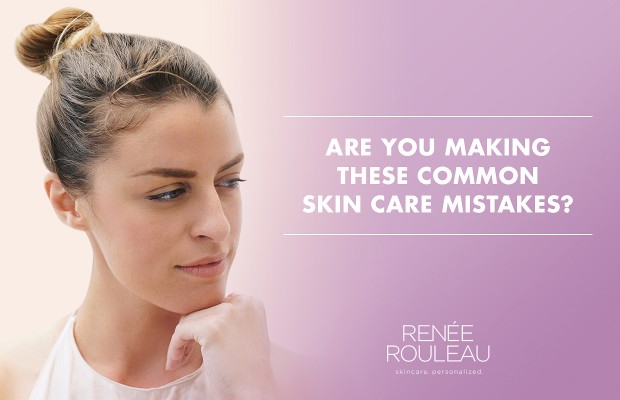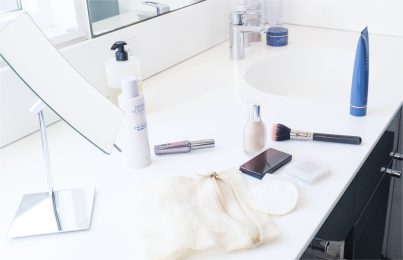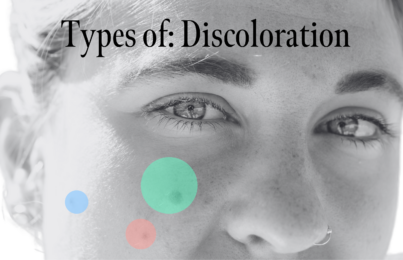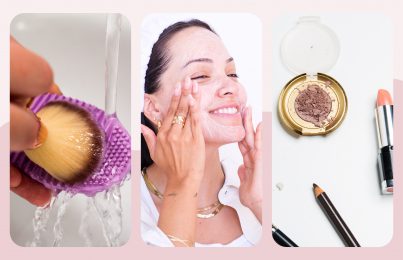Updated 9/25/20 As an esthetician, my job is to advise my clients about the best way to care for their individual skin type. Through an initial in-depth conversation, I uncover how they are currently caring for their skin and what they might be missing. These are the five most common skincare mistakes I see people making, in no particular order.
- Mistake #1: Skipping the Use of A Facial Scrub (Especially for Those With Discoloration)
- Mistake #2: Not Wearing Foundation Makeup Daily
- Mistake #3: Not Wearing Enough Sunscreen on The Neck
- Mistake #4: Treating Blemishes the Wrong Way
- Mistake #5: Not Using the Right Routine to Manage Both Wrinkles AND Adult Acne
Mistake #1: Skipping the Use of A Facial Scrub (Especially for Those With Discoloration)
While so many people are using acid exfoliators to improve their skin, they are forgetting the importance of using another type of exfoliant that can be a TOTAL game-changer for making brown spots and post-breakout scars less noticeable: a good facial scrub.
How to Fix It:
If your goal is to make the skin look more even-toned (especially post-summer), the use of both chemical and physical exfoliants are the way to go for a quick fix. (Long-term use of retinol will help, too.) So, here’s how it works. A chemical exfoliator that uses acids such as glycolic, lactic, mandelic and salicylic, all help to lower the pH of the skin which in turn, will dissolve and digest expired, pigmented cells. However, the key to removing the discolored cells is when you actually physically polish off and lift away these cells. A gentle facial scrub can do this beautifully. Both of these types of exfoliators work synergistically to fade breakout scarring and get rid of sun spots.
Learn more about the benefits of a facial scrub.
Mistake #2: Not Wearing Foundation Makeup Daily
So many of my clients I have seen through the years will hide their sun damage, blemishes, scarring, and brown spots under makeup, and they come to me with the goal of perfecting their skin so they can go makeup-free. Other clients don’t have much they want to cover up, so they think that wearing foundation makeup is not needed and that not wearing it is helping their skin by letting it “breathe.” All of this is so false and not wearing makeup is a big mistake in my professional opinion.
How to Fix It:
For starters, the skin doesn’t have a respiratory system, so thinking that the skin breathes is a total myth. I like to educate my clients to think of makeup as a skincare product because, during daylight hours, it protects your skin from UV light and environmental damage.
Most forms of liquid or powder foundations contain ingredients like titanium dioxide that naturally act as protection against UV rays. Even if your makeup doesn’t indicate it has SPF, it is definitely still guarding your skin against the sun’s damaging rays. Keep in mind that the #1 cause of premature wrinkles is not from age, genetics, or even smoking, it’s from incidental UV exposure that you get at home, at work, or riding in the car. If your goal is to prevent unnecessary damage to your skin, wearing some form of makeup daily is a MUST.
Lots of people ask me for my opinion on the best type of makeup to use. There isn’t one that works for every type of skin, so you just have to experiment to see what you’ll enjoy wearing daily. Most days I wear Chanel Ultra Le Teint Foundation which actually does have SPF, but sometimes I’ll just wear Revlon ColorStay powder, which does not have SPF but does include titanium dioxide so it serves its purpose. As for liquid makeup, check out my review of the best foundation for oily, acne-prone skin.
Mistake #3: Not Wearing Enough Sunscreen on The Neck
If you’re reading this post, more than likely you’re someone who makes a conscious effort to take care of their skin. But when it comes to wearing sunscreen on the neck, many people make this mistake: you apply a moisturizer with SPF to your face, and then whatever is leftover on your fingertips get carried down onto the neck, right? While I’m happy that you’re giving your neck some attention, I can assure you, it’s definitely not enough!
Correction:
This always comes as a surprise when I explain it to my clients, but the protection you get from sunscreen is less about how high the SPF number is and more about how generously you apply it. If you apply an SPF 50 sparingly, it could very well be giving you the protection factor of an SPF 4. For anyone over age 40 like me, you know firsthand how the neck loses tone and gets discoloration and wrinkles. (Read this post where I talk about my neck and chest.) Your neck is an extension of your face, so treat it with the same respect.
Apply a generous layer of sunscreen to the front and sides of the neck, including your chest if you’re wearing a shirt or dress that exposes this area. At night, indulge the skin on your neck with a well-formulated neck cream.
Mistake #4: Treating Blemishes the Wrong Way
This is one mistake that literally everyone I come in contact with who deals with breakouts is making. I don’t blame them because no one has ever taught them the right way to respond to a blemish the moment it appears. Do you immediately dry it out with a spot treatment the moment it appears? Probably so, but I’m here to tell you, don’t do that.
When a blemish appears, your body has incredible repair mechanisms (unless you have an immune deficiency disorder) that immediately recognize an infection and then kick into high gear to heal it. The problem comes when you, thinking you’re helping, interfere with these natural processes and end up making it worse. What you must understand is that there is a life cycle to the blemish and it’s important that you’re treating it in sync with the natural healing process.
Correction:
When you get a red, painful blemish, ONE of two things will happen: The infection inside the blemish will work its way up to the surface of the skin resulting in a white head. If your skin could talk, it would say, “There is an infection and I want it out. The way I’ll take care of this is to excrete the infection through the skin’s surface.” This type of blemish is called a pustule.
OR
The infection will NOT come up to the surface. It will stay deep within the skin until the body eventually re-absorbs it. If your skin could talk, it would say, “I’m just going to hang out down here for a bit. Don’t worry, I’ll go away on my own.” This type of blemish is called a cyst.
FOR PUSTULAR BLEMISHES:
It’s best to not act the minute you feel it coming on, instead, wait a day or two for the infection to appear on the surface. Waiting will allow you to effectively control the blemish without damaging the skin. Once the whitehead is truly visible, gently squeeze out the infection with your fingers wrapped in tissue, and then apply a spot-drying treatment that will work its way into the skin and eradicate any lingering infection. If you apply a drying treatment before the whitehead is on the surface, it will simply dry out the surface of the skin. This keeps the infection trapped underneath for longer which causes the infection to stretch the surrounding skin tissue and sets off a response that creates discoloration and leaves behind a dark acne scar that will linger for weeks or even months.
FOR CYSTIC BLEMISHES:
Mostly occurring in the chin and jaw areas, it is important to remember that cysts are like submarines; they are meant to stay under the skin. No matter what method you employ, cysts will never rise to the surface of the skin. This means no picking! (Read my posts about how to stop picking at your face.)
To learn more about which products to use at the right healing phase of the blemish, check out this Zit Care Kit.
Mistake #5: Not Using the Right Routine to Manage Both Wrinkles AND Adult Acne
This one is common for those between the ages of 25-35 who still get clogged pores and breakouts yet are starting to notice fine lines and wrinkles. Their home routine is either only addressing the breakouts with drying acne products, or they don’t have anything to prevent blemishes and are heavy anti-aging products that can clog pores. I realize that this type of skin is probably the most challenging because what your skin really needs is the best of both worlds.
(I believe there are nine different skin types and skin type #2 is an example of one that specifically addresses the needs of both breakouts and aging. Find out your true skin type by taking this quiz.)
Correction:
Any acne product that leaves your skin feeling tight, dry, and irritated is most definitely a no-no, as this creates dry skin cell buildup on the surface that traps oil and bacteria within the pores and can lead to more breakouts. Any product formulated for healthy aging that feels remotely greasy on the skin is not good either because acne-prone skin needs less oil since oil breeds bacteria and bacteria will lead to breakouts.
I would say the best strategy for managing all your skin’s needs is to first understand how to prevent adult hormonal breakouts. In addition, you’ll want to use a gentle salicylic acid exfoliant under moisturizer three nights a week. Salicylic acid is a beta hydroxy acid that penetrates into the pore lining to clear out bacteria, preventing the formation of blemishes. It is also good for smoothing and encouraging cell turnover needed to keep skin looking and acting young. Using a performance product like this along with a sulfate-free cleanser, alcohol-free toner, a lightweight moisturizer and oil-free serums loaded with soothing antioxidants can make for a great routine that gives your skin the balance it so desperately needs to be healthy and clear.
Trust me when I say that I know you’re trying your best to do the right thing with the knowledge you have, but hopefully this post will help you to truly know the correct way to care for your individual skin type.
Learn about how to create the perfect morning skincare routine and evening routine.
Celebrity Esthetician & Skincare Expert
As an esthetician trained in cosmetic chemistry, Renée Rouleau has spent 35 years researching skin, educating her audience, and building an award-winning line of products. Her hands-on experience as an esthetician and trusted skin care expert has created a real-world solution — products that are formulated for nine different types of skin so your face will get exactly what it needs to look and feel its best. Trusted by celebrities, editors, bloggers, and skincare obsessives around the globe, her vast real-world knowledge and constant research are why Marie Claire calls her “the most passionate skin practitioner we know.”




Comments:
I am having a problem regarding the sunspots on my face. I have tried aloe vera extract for several months but there was no effect. I am planning to use your products however it is not available in the Philippines. How will I avail this items since I am interested too?
Posted By: Eden Roberonta |
You can order our products on our website. We ship to the Philippines.
Posted By: Renée Rouleau |
I found the point about pustules vs cysts very helpful Renee. I’ve got both at the same time.
Posted By: Colette |
Hello Renee,
I just wanted to tell you that I am a new user of your products and I’m absolutely in lOVE!!!!!!! I have seen a difference immediately after the first use and I look forward to putting it on day and night. I know customers are quick to point out the negative but I just thought that there are lots of positives too and you are doing an amazing job with your products. I’m buying more and more as I truly love how they are making a difference. Thought you would like to hear this feedback have a wonderful week,
Vanessa
Posted By: Vanessa |
Thank you for your kind words, Vanessa. Stick with me, you’re in good hands!
Posted By: Renée Rouleau |
I understand why you included not wearing foundation, but if you’re wearing spf properly everyday, and reapplying, why should wearing makeup be important? And how would you recommend people who do wear foundation to reapply their spf during the course of the day?
Posted By: Erin Freeman |
Great question, Erin! If you are reapplying every few hours when in direct sunlight (such as the pool or beach) then you don’t need to wear makeup. But let’s say on a normal weekday when you’re just running around, work, errands, in and out of the car, going for a walk etc, then sunscreens can degrade due to oil production in the t-zone and UV light, too. So the best way to touch up sunscreen if you already have makeup on is to use an SPF-infused mineral powder. You just dust it on every few hours, it’s super easy. I like and recommend this one.
Posted By: Renée Rouleau |
Your blog posts are always so practical and to the point. I really enjoy them! Thanks for the tips, especially for acne sufferers.
Posted By: Grace |
Thanks for the nice comment, Grace!
Posted By: Renée Rouleau |